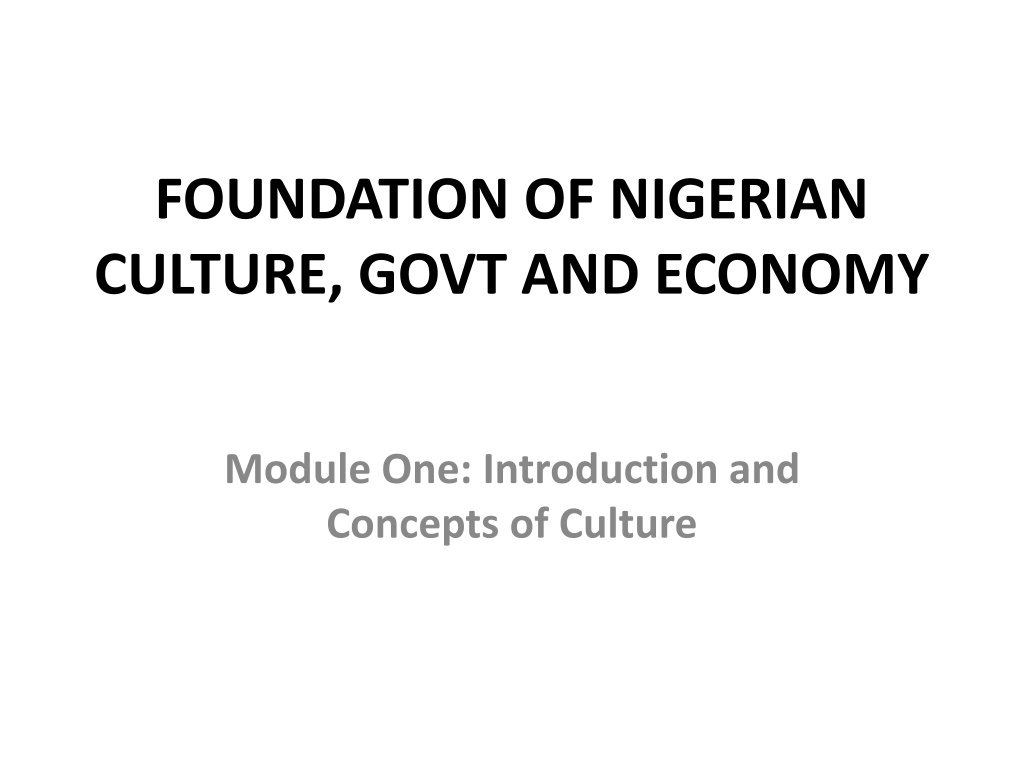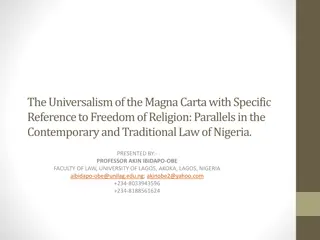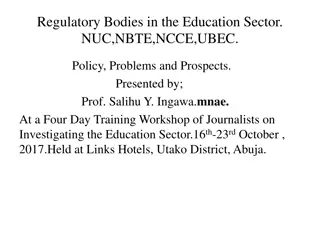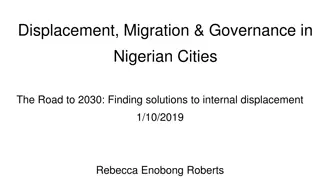Understanding Nigerian Culture, Government, and Economy: Module One
Delve into Module One of the course on Nigerian culture, government, and economy with a focus on the Introduction and Concepts of Culture. Explore definitions of culture, various types of culture, characteristics, importance, related concepts, levels, and differences between culture and ethnic groups as outlined by scholars in the field. Gain insights into the complexities and nuances that define cultures within societies.
Download Presentation

Please find below an Image/Link to download the presentation.
The content on the website is provided AS IS for your information and personal use only. It may not be sold, licensed, or shared on other websites without obtaining consent from the author. Download presentation by click this link. If you encounter any issues during the download, it is possible that the publisher has removed the file from their server.
E N D
Presentation Transcript
FOUNDATION OF NIGERIAN CULTURE, GOVT AND ECONOMY Module One: Introduction and Concepts of Culture
Kabir Bello,PhD Associate Professor, Department of Sociology, Bayero University, Kano
Introduction and Concepts of Culture Module One: Introduction and Concepts of Culture Learning Outcomes It is expected that at the end of this chapter students should be able to learn the following: Definitions of culture Types of culture Characteristics of culture Importance of culture Concepts related to culture such as sub-culture, ethnocentrism, status and role, etc Levels of culture Difference between culture and ethnic group.
Definitions of Culture Culture is a difficult term to define because it means different thing to different people. Several attempts to define the concept has been made by a number of scholars in different disciplines in the social sciences. However, some definitions of the term will help to further illuminate its meanings.
Tylors culture as that complex whole which includes knowledge, beliefs, art, morals, laws, customs and any other capabilities and habits acquired by man as a member of society (p. 1) Kroeber (1952) defined culture as the historically differentiated and variable mass of customary ways of functioning of human societies (p. 157 Primitive Culture (1871) defined
Parsons and Shils (1951) intimate that culture is composed of a set of values, norms, and symbols that guide individual behavior. Herskovits (1955) later argued that there is a general agreement that culture is learned; that it allows man to adapt himself to his natural and social setting; that it is greatly variable; that it is manifested in institutions, thought patterns, and material objects (p. 305).
A number of scholars have focused on shared values as the central distinguishing characteristic of a culture. Values refer to relationships among abstract categories that are characterized by strong affective components and imply a preference for a certain type of action. According to Rokeach (1973), a value is: feature and
An enduring belief that a specific mode of conduct or end-state of existence is personally or socially preferable to an opposite or converse mode of conduct or end-state of existence. A value system is an enduring organization of beliefs concerning preferable modes of conduct or end-states of existence along a continuum of relative importance. (p. 5)
In addition, Kluckholns (1951) definition of culture draws attention to shared patterns of thinking based on values. He defines culture as: Patterned ways of thinking, feeling and reacting, acquired and transmitted mainly by symbols, constituting the distinctive achievements of human groups, including their embodiments in artifacts; the essential core of culture consists of traditional (i.e., historically derived and selected) ideas and especially their attached values. (p. 86)
Types of Culture There broadly two major types of culture. 1. Material and 2. non-material Material culture refers to the physical objects, resources, and spaces that people use to define their culture. These include homes, cities, schools, churches, synagogues, temples, mosques, offices, factories and plants, tools, means of production, goods and products, stores, and so forth. All of these physical aspects of a culture help to define its members' behaviors and perceptions. For example, technology is a vital aspect of material culture in modern society.
Nonmaterial culture refers to the nonphysical ideas that people have about their culture, including beliefs, values, rules, norms, morals, language, organizations, and institutions. For instance, the non material cultural concept of religion consists of a set of ideas and beliefs about God, worship, morals, and ethics. These beliefs, then, determine how the culture responds to its religious topics, issues, and events. When considering non material culture, sociologists refer to several processes that a culture uses to shape its members' thoughts, feelings, and behaviors. Four of the most important of these are symbols, language, values, and norms.
1. Characteristics of Culture Learned Behaviour: Not all behaviour is learned, but most of it is learned; combing one s hair, standing in line, telling jokes, and going to the school, all constitute behaviours which had to be learned. In addtion, The definition of culture indicated that the learned behaviour of people is patterned. Each person s behaviour often depends upon some particular behaviour of someone else. The point is that, as a general rule, behaviours are somewhat integrated or organized with related behaviours of other persons. 1. Culture is Abstract: Culture exists in the minds or habits of the members of society. Culture is the shared ways of doing and thinking. There are degrees of visibility of cultural behaviour, ranging from the regularised activities of persons to their internal reasons for so doing. In other words, we cannot see culture as such we can only see human behaviour. This behaviour occurs in regular, patterned fashion and it is called culture.
3. Culture includes Attitudes, Values Knowledge: There is widespread error in the thinking of many people who tend to regard the ideas, attitudes, and notions which they have as their own . It is easy to overestimate the uniqueness of one s own attitudes and ideas. When there is agreement with other people it is largely unnoticed, disagreement or difference one is usually conscious of it. Your differences however, may also be cultural. For example, suppose you are a Catholic and the other person a Protestant. but when there is a
5. Culture is shared by the Members of Society: The patterns of learned behaviour and the results of behaviour are possessed not by one or a few person, but usually by a large proportion. Thus, many millions of persons share such behaviour patterns as Christianity, the use of automobiles, or the English language. Persons may share some part of a culture unequally. For example, as Americans do the Christian religion. To some persons Christianity is the all important, predominating idea in life. To others it is less preoccupying/important, and to still others it is of marginal significance only.
Sometimes the people share different aspects of culture. For example, among the Christians, there are Catholic and Protestant, liberal or conservation, as clergymen or as laymen. The point to our discussion is not that culture or any part of it is shared identically, but that it is shared by the members of society to a sufficient extent.
6.Culture is Pervasive: Culture is pervasive it touches every aspect of life. The pervasiveness of culture is manifest in two ways. First, culture provides an unquestioned context within which individual action and response take place. Not only emotional action but relational actions are governed by cultural norms. Second, culture pervades social activities and institutions. According to Ruth Benedict, A culture, like an individual is a more or less consistent pattern of thought and action. With each culture there come into being characteristic purposes not necessarily shared by other types of society.
7. Culture is transmitted among members of Society: The cultural ways are learned by persons from persons. Many of them are handed down by one s elders, by parents, teachers, and others [of a somewhat older generation]. Other cultural behaviours are handed up to elders. Some of the transmission of culture is among contemporaries. For example, the styles of dress, political views. One does not acquire a behaviour pattern spontaneously. He learns it. That means that someone teaches him and he learns. Much of the learning process both for the teacher and the learner is quite unconscious, unintentional, or accidental.
8. Culture is Continually Changing: There is one fundamental and inescapable attribute (special quality) of culture, the fact of unending change. Some societies at sometimes change slowly, and hence in comparison to other societies seem not to be changing at all. But they are changing, even though not obviously so. 9. Culture is Variable: Culture varies from society to society, group to group. Hence, we say culture of India or England. Further culture varies from group to group within the same society. There are subcultures within a culture. Cluster of patterns which are both related to general culture of the society and yet distinguishable from it are called subcultures.
10. Language is the Chief Vehicle of Culture: Man lives not only in the present but also in the past and future. He is able to do this because he possesses language which transmits to him what was learned in the past and enables him to transmit the accumulated wisdom to the next generation. A specialised language pattern serves as a common bond to the members of a particular group or subculture. Although culture is transmitted in a variety of ways, language is one of the most important vehicles for perpetuating cultural patterns.
Importance of Culture Culture has a number of functions/importance some of which are: 1. Culture Defines Situations: Each culture has many subtle cues which define each situation. It reveals whether one should prepare to fight, run, laugh or make love. One does not know what to do in a situation until he has defined the situation. Each society has its insults and fighting words. The cues (hints) which define situations appear in infinite variety. A person who moves from one society into another will spend many years misreading the cues. For example, laughing at the wrong places.
2.Culture defines Attitudes, Values and Goals: Each person learns in his culture what is good, true, and beautiful. Attitudes, values and goals are defined by the culture. While the individual normally learns them as unconsciously as he learns the language. Attitude are tendencies to feel and act in certain ways. Values are measures of goodness or desirability, for example, we value family and many other things and experience. Goals are those attainments which our values define as worthy, (e.g.) winning a competition, gaining the affections of a particular girl, or becoming president of the firm. By approving certain goals and ridiculing others, the culture channels individual ambitions. In these ways culture determines the goals of life.
3.Culture defines Myths, Legends, and the Supernatural: Myths and legends are important part of every culture. They may inspire, reinforce effort and sacrifice and bring comfort in bereavement. Whether they are true is sociologically unimportant. Ghosts are real to people who believe in them and who act upon this belief. We cannot understand the behaviour of any group without knowing something supernatural beliefs they hold. Myths and legends are powerful forces in a group s behaviour. Culture also provides the individual with a ready-made view of the universe. The nature of divine power and the important moral issues are defined by the culture. The individual does not have to select, but is trained in a Christian, Buddhist, Hindu, Muslim or some other religious tradition. This tradition gives answers for the major (things imponderable) of life, and fortuities the individual to meet life s crises. of the myths, legends, and
4. Culture provides Behaviour Patterns: The individual need not go through painful trial and error learning to know what foods can be eaten (without poisoning himself), or how to live among people without fear. He finds a ready-made set of patterns awaiting him which he needs only to learn and follow. The culture maps out the path to matrimony. The individual does not have to wonder how one secures a mate; he knows the procedure defined by his culture. If men use culture to advance their purposes, it seems clear also that a culture imposes limits on human and activities. The need for order calls forth another function of culture that of so directing behaviour that disorderly behaviour is restricted and orderly behaviour is promoted. A society without rules or norms to define right and wrong behaviour would be very much like a heavily travelled street without traffic signs or any understood rules for meeting and passing vehicles. Chaos would be the result in either case.
Concepts Related to Culture Sub-Culture: This refers to clusters related to the general culture of the society and yet distinguishable from it, examples of which may include: occupational, religious, regional, age, gender, etc. All complex societies do not have a uniform culture because of differentiations and relativity of norms and values coupled with heterogeneity, but instead may also have subcultures. Subcultures dominant cultural patterns for offering to the individual different ways to respond to the basic values of the larger society, while retaining his sub-culture. serve to reinforce the
Ethnocentrism: Sumner as cited in Coser and Rosenberg (1982) saw the concept of ethnocentrism as that view of things in which one s own group is the centre of everything and all others are scaled and rated with reference to it. In other words, it is the tendency to for each group to take for granted the superiority of its culture. Ethnocentrism is used as a yardstick to measure all other cultures, whether as good or bad, high or low . Some of the positive expressions can be in the form of describing one s culture as true believers, chosen people, superior culture, or race while negatively other cultures are labeled as infidels, barbarians, savages, devils, etc progressives, dirty, backward,
Cultural relativism: Cultures vary (different) across societies, never the same. Different cultural groups think, feel, and act differently. There are no scientific considering one group as intrinsically superior or inferior to another. Studying differences in culture among groups presupposes a position of cultural relativism (Li and Karakowsky, 2001). standards for and societies
Status It is often associated with prestige sociologists use the word status to refer to position in society .Everybody occupies a number of statuses student, lawyer, son, father, mother, etc. Weber saw status as the effective claim of social esteem in terms of positive and negative privileges(Weber, 1947). Status determines how a person fits the position in society i.e. how she/he relates with other members for a daughter as status shows how she relates with members of the family. Although one can occupy several statuses simultaneously, usually an occupational status tends to be the most important/significant, and this is often called master status
Roles Roles represent the dynamic aspect of statuses .It refers to a bundle of expectations, a role is the part the person plays like in a theatre (film), it is the part the person plays in society. A role is a set of expected behavior patterns, obligations and privileges attached to a particular social status. For example, a lawyer is a social status, and attached to it is a professional role, defined by social norms, prescribing how the occupier (Lawyer) should behave. A single status (A lawyer) may involve a number of roles (with fellow lawyers, judges, prison officers, clients, police etc).
Levels of Culture Individuals as members of different social groups found themselves in different levels of culture in the society stated by Hofstede (1997), as follows: a national level according to one s country (or countries for people who migrated during their lifetime); a regional and/or ethnic and/or religious and/or linguistic affiliation, as most nations are composed of culturally different regions and/or ethnic and/or religious and/or language groups; a gender level, according to whether a person was born as a girl or as a boy;
a generation level, which separates grandparents from parents from children; a role category, e.g. parent, son/daughter, teacher, student; a social class level, associated with educational opportunities and with a person s occupation or profession; for those who are employed, an organizational or corporate level according to the way employees have been socialized organization(Hofstede,1997: 10). by their work
Ethnic Group Closely related to culture is the concept of ethnic group. Ethnic groups denotes a large aggregate of people who have a self-defined name, believe they share a common descent, have common historical memories and elements of shared culture (such as religion and language), and have an attachment (even if only historical and sentimental) to a specific territory. Ethnic groups tend to have solidarity and we-feeling; their members experience something of ourselves in each other.























